 Abraham Lincoln is the most memorialized president in American history, in terms of the number of monuments and statues in all fifty states and the U.S. territories. According to the National Monument Audit completed in 2021, there were 193 Lincoln monuments in America, followed by George Washington at 171, Christopher Columbus at 149, and Martin Luther King Jr. with 86. Those numbers keep changing – several new Lincoln statues have gone up in 2023 alone, and statues to Columbus and Confederate General Robet E. Lee are being removed. But Lincoln is likely to continue to have the most statues. That said, not all of them are great. Some of them are downright controversial.
Abraham Lincoln is the most memorialized president in American history, in terms of the number of monuments and statues in all fifty states and the U.S. territories. According to the National Monument Audit completed in 2021, there were 193 Lincoln monuments in America, followed by George Washington at 171, Christopher Columbus at 149, and Martin Luther King Jr. with 86. Those numbers keep changing – several new Lincoln statues have gone up in 2023 alone, and statues to Columbus and Confederate General Robet E. Lee are being removed. But Lincoln is likely to continue to have the most statues. That said, not all of them are great. Some of them are downright controversial.
Among the controversial ones are Thomas Ball’s Emancipation Memorial, aka the Freedman’s Memorial, in Lincoln Park, Washington, DC. From its dedication in 1876, its visual depiction of a standing Lincoln and a kneeling African American man beginning to rise from enslavement, the statue has been problematic. A copy of it was removed from its pedestal in Boston during the protests of 2020, while activists attempted to have it taken down in Washington (a bill to have it removed has been introduced by DC Delegate Eleanor Holmes Norton). The fact that it was paid for entirely from funds raised by the formerly enslaved and that Frederick Douglass keynoted the dedication has not kept the discomfort at bay. Meanwhile, the so-called “belly-ache” statue by George Grey Barnard was vehemently attacked by none other than Robert T. Lincoln, the only living son of Lincoln. Robert successfully kept a copy of that statue from being placed in London. The original did get placed in Lytle Park in Cincinnati, with the copy going off to Manchester, England while a copy of Chicago’s Augustus Saint-Gaudens statue is now featured prominently in Parliament Square, London.
Which gets us back to Vermont. Yes, Vermont.
During my recent travels in New England I stopped at Hildene, which I’ll have more about later. Down the road in Bennington, Vermont is the Bennington Museum, in front of which stands a Lincoln grouping called “The Lincoln Trilogy,” although it is also known by a reimagined name, “The American Spirit.” At first glance you can see why the statue is controversial.
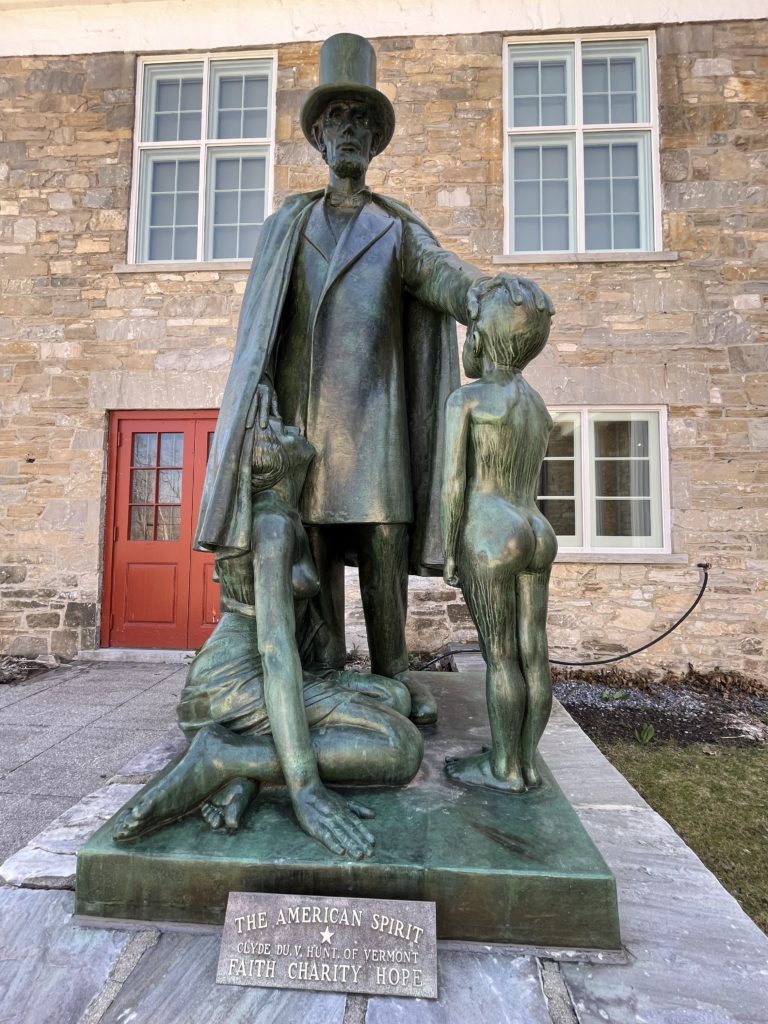
Lincoln stands fully clothed, complete with a heavy cape and top hat. Sitting at his feet is a barely covered female figure looking up to him from his waist. He has his hand on her head. His other hand grasps the head of a small boy, unclothed and standing below him. The juxtaposition of the three figures is jarring, at best, even after taking a while to examine it. What could the artist have been thinking?
For one, the artist was not originally thinking the three figures were designed to be placed together.
The standing figure of the boy is called Fils de France, designed independently in 1918 to reflect a young boy gazing intently into the distance symbolizing rebirth of France following the devastation of World War I. The female figure was also produced in 1918 and in response to the War. Called Nirvana, the statue was originally completely nude, the woman’s attitude of tranquility personified the Buddhist concept of nirvana as a spiritual emancipation from passion, hatred, and delusion. Both individual statues are inside the Museum. They follow the stylistic tradition of idealized nude figures developed by the ancient Greeks and Romans. The Lincoln statue provides a stark contrast. One of many Lincoln statues the artist, Clyde du Vernet Hunt, created in his lifetime, it reflects a tribute to Lincoln as an actual historical figure. Hunt revered Lincoln as an idealist, humanitarian, and emancipator, which he tried to capture in the powerfully majestic pose of the statue. Each statue was designed to stand on its own merits and meanings.
Clyde du Vernet Hunt was born in Scotland to American parents traveling in Europe. His grandfather had been a U.S. Congressman and his father served in the adjutant-general’s department during the Civil War. Clyde Hunt studied engineering and art and maintained a studio in Paris and home in Vermont. Hunt was invited to exhibit his work at the Palais des Beaux-Arts in Paris in 1918, a remarkable achievement for an American artist. He submitted his bronze Fils de France (the boy sculpture) and the marble Nirvana (the woman sculpture), both of which received favorable reviews. A decade later, the Societe des Artistes Francais asked him to participate in the exclusive Paris Salon. He created a large plaster group combining the Lincoln statue with the figures of Nirvana and Fils de France. Lincoln and the boy are exact duplicates of the original versions, but Hunt enlarged the female figure of Nirvana and discretely draped the nude female for inclusion in the grouping. [How discrete the draping is a matter of opinion]. Hunt entitled the grouping simply “Lincoln” for the Paris Salon but envisioned it as representing the ideals of Faith (Nirvana), Hope (Fils de France), and Charity (Lincoln, from his “charity for all and malice toward none”). Within this context back in the states, the Fils de France was reinterpreted as “young America.”
The Museum admits that the intellectual concept behind the Lincoln Trilogy was more successful than the visual relationship of the three figures. Even they admit the combination of three distinctly individual sculptures of differing scale and spatial orientation is “somewhat awkward.” After returning to the US in 1938, Hunt cast the trilogy in bronze for display at the New York World’s Fair. Hunt’s heirs presented the bronze trilogy to the Bennington Museum in 1949, where the director of the museum appended the title “The American Spirit” to the statues, an interpretation influenced by the nationalism of the 1940s. So whereas one of the statues depicts a Civil War president, and two of the statues were influenced by World War I, the reinterpretation and retitling came about due to World War II.
Despite the controversy, the statue grouping is worth a visit. The Bennington Museum is a short drive from Robert T. Lincoln’s summer home at Hildene, so definitely put it on your agenda if you’re in the area.
[Photos by David J. Kent]

Lincoln: The Fire of Genius: How Abraham Lincoln’s Commitment to Science and Technology Helped Modernize America is available at booksellers nationwide.
Limited signed copies are available via this website. The book also listed on Goodreads, the database where I keep track of my reading. Click on the “Want to Read” button to put it on your reading list. Please leave a review on Goodreads and Amazon if you like the book.
You also follow my author page on Facebook.
David J. Kent is President of the Lincoln Group of DC and the author of Lincoln: The Fire of Genius: How Abraham Lincoln’s Commitment to Science and Technology Helped Modernize America and Lincoln: The Man Who Saved America.
His previous books include Tesla: The Wizard of Electricity and Edison: The Inventor of the Modern World and two specialty e-books: Nikola Tesla: Renewable Energy Ahead of Its Time and Abraham Lincoln and Nikola Tesla: Connected by Fate.



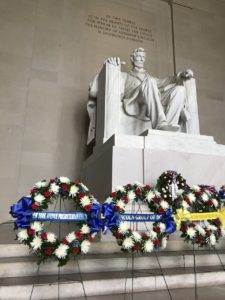 Finally! The long-delayed renovations to the Lincoln Memorial are about to start. My colleague in the Lincoln Group of DC, Ed Epstein, reported on the official U.S. National Park Service announcement this morning. Writing on the
Finally! The long-delayed renovations to the Lincoln Memorial are about to start. My colleague in the Lincoln Group of DC, Ed Epstein, reported on the official U.S. National Park Service announcement this morning. Writing on the 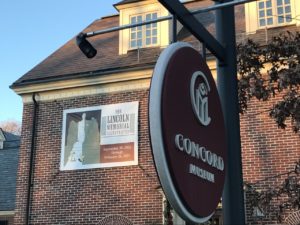 It seems Abraham Lincoln is everywhere. Our continuing “unexpected Lincoln” series takes us to Concord, Massachusetts, home of Henry David Thoreau and just steps away from “the shot heard round the world.” I stopped in Concord on a recent road trip to see a special Lincoln Memorial Centennial exhibit at Concord Museum. Not only was Lincoln there, but it turns out Concord was a hotbed of abolitionist fever – and famous thinkers so thick you couldn’t help running into one in the 1840s-50s.
It seems Abraham Lincoln is everywhere. Our continuing “unexpected Lincoln” series takes us to Concord, Massachusetts, home of Henry David Thoreau and just steps away from “the shot heard round the world.” I stopped in Concord on a recent road trip to see a special Lincoln Memorial Centennial exhibit at Concord Museum. Not only was Lincoln there, but it turns out Concord was a hotbed of abolitionist fever – and famous thinkers so thick you couldn’t help running into one in the 1840s-50s.

 The Lincoln Memorial reaches its centennial this month and this past week was the culmination of a year’s worth of work to celebrate the iconic structure’s 100th birthday. Around this time last year, the Lincoln Group of DC, of which I am the current president, decided that we must have a magnificent event on the Memorial steps. We had done something similar in 2015 for the sesquicentennial of Abraham Lincoln’s second inaugural speech so we followed the basic format. There were differences of course. We couldn’t really have a Lincoln reenactor for a memorial to his life and death, especially since it wasn’t dedicated until 57 years after his assassination. We also couldn’t just recapture the Civil War theme, nor did we want to exactly recapture the segregationist Jim Crow-era time of 1922. Plus, we would be working with the National Park Service, which would prefer not to be overly controversial. Still, there were issues from that 1922 dedication we wanted to address and there has been 100 years of history we wanted to show.
The Lincoln Memorial reaches its centennial this month and this past week was the culmination of a year’s worth of work to celebrate the iconic structure’s 100th birthday. Around this time last year, the Lincoln Group of DC, of which I am the current president, decided that we must have a magnificent event on the Memorial steps. We had done something similar in 2015 for the sesquicentennial of Abraham Lincoln’s second inaugural speech so we followed the basic format. There were differences of course. We couldn’t really have a Lincoln reenactor for a memorial to his life and death, especially since it wasn’t dedicated until 57 years after his assassination. We also couldn’t just recapture the Civil War theme, nor did we want to exactly recapture the segregationist Jim Crow-era time of 1922. Plus, we would be working with the National Park Service, which would prefer not to be overly controversial. Still, there were issues from that 1922 dedication we wanted to address and there has been 100 years of history we wanted to show.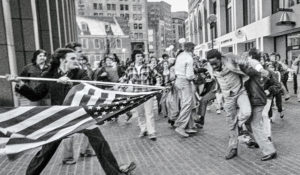 Emmett Till, a 14-year-old African American falsely accused of flirting with a white woman, was lynched in 1955. George Floyd died under the knee of a police officer in 2020. Together, and with thousands of other examples and millions of cases, the long history of systemic racism continues in America. To provide some background, what follows is a brief outline of the history of systemic racism and discrimination in the United States.
Emmett Till, a 14-year-old African American falsely accused of flirting with a white woman, was lynched in 1955. George Floyd died under the knee of a police officer in 2020. Together, and with thousands of other examples and millions of cases, the long history of systemic racism continues in America. To provide some background, what follows is a brief outline of the history of systemic racism and discrimination in the United States.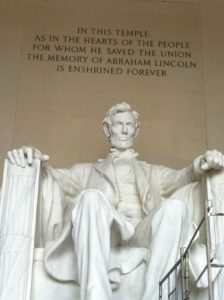 Abraham Lincoln is best known for his Emancipation Proclamation, Gettysburg Address, and saving the Union during the Civil War. But in this Black History Month it’s important to remember that Lincoln also pushed for black voting rights.
Abraham Lincoln is best known for his Emancipation Proclamation, Gettysburg Address, and saving the Union during the Civil War. But in this Black History Month it’s important to remember that Lincoln also pushed for black voting rights.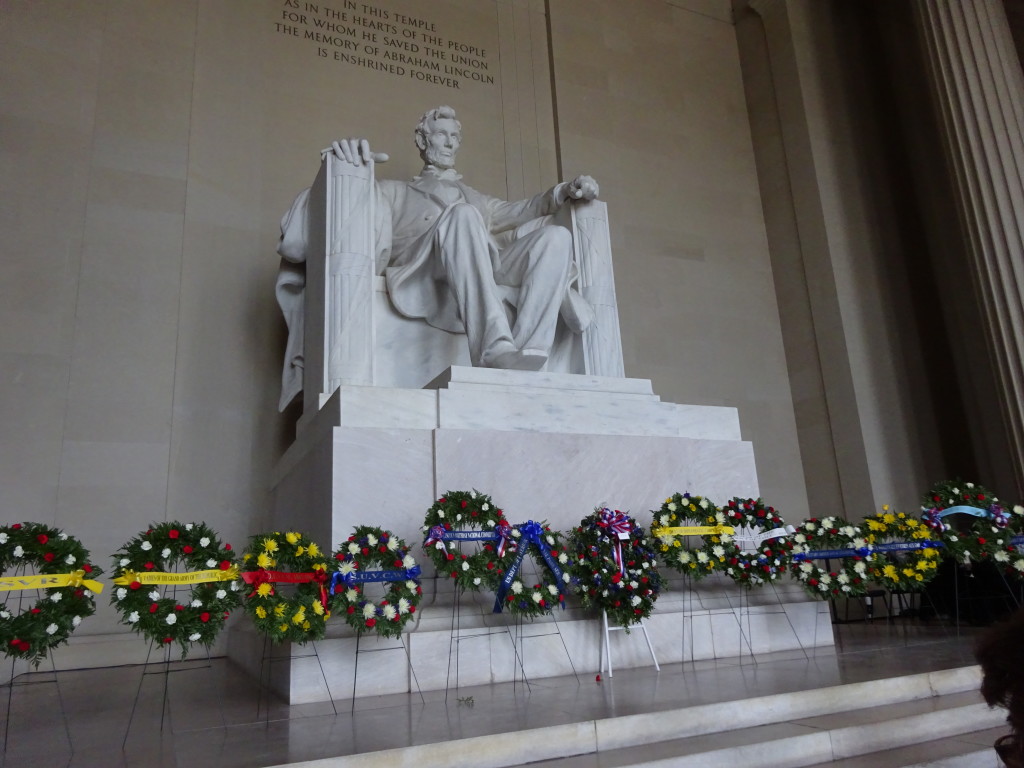
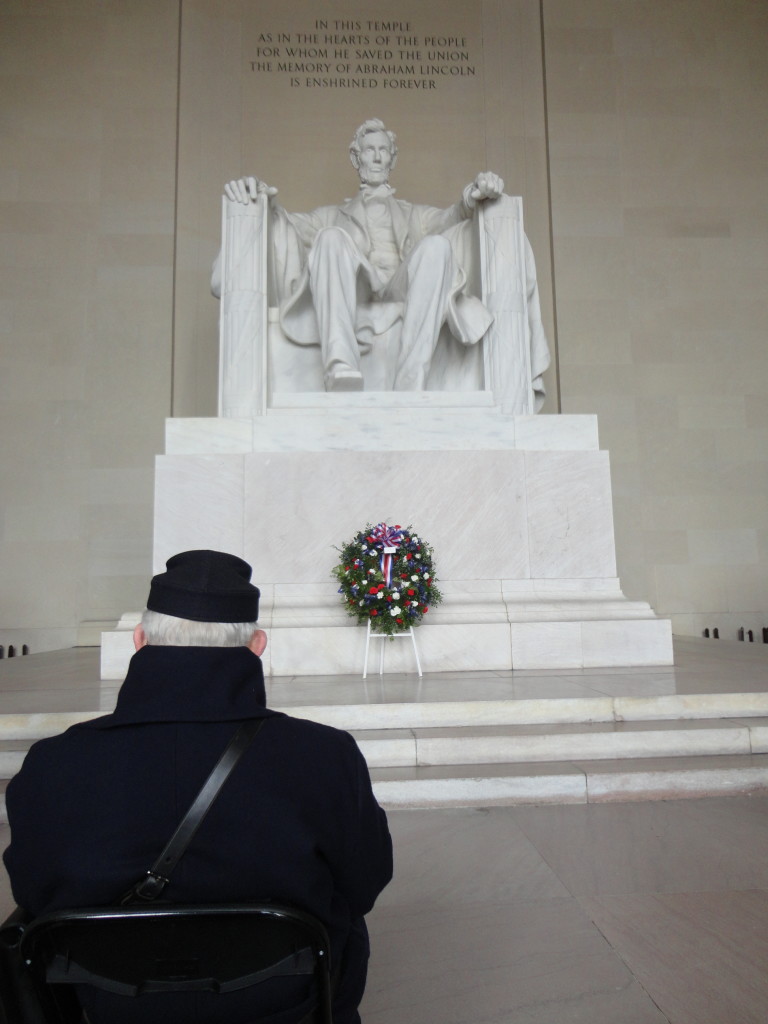

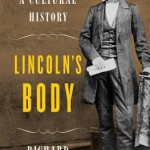 Historian Richard Wightman Fox employs a unique concept in discussing Abraham Lincoln: Lincoln’s body. His body – the physical, the figurative, the aura, and the memory – is used to trace how he was perceived at the time and during several periods since then to the present day. In doing so, Fox has successfully provided a mirror into not only Abraham Lincoln, but ourselves.
Historian Richard Wightman Fox employs a unique concept in discussing Abraham Lincoln: Lincoln’s body. His body – the physical, the figurative, the aura, and the memory – is used to trace how he was perceived at the time and during several periods since then to the present day. In doing so, Fox has successfully provided a mirror into not only Abraham Lincoln, but ourselves.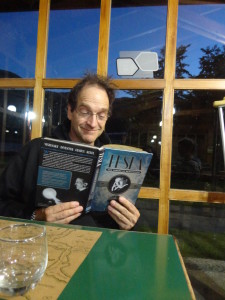
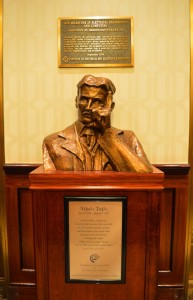
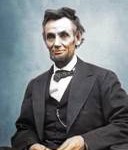 This is Part Two of a series about inauguration speeches, in particular that of Abraham Lincoln, whose bible was used by President Barack Obama for both his first and second inaugurations. It is best to
This is Part Two of a series about inauguration speeches, in particular that of Abraham Lincoln, whose bible was used by President Barack Obama for both his first and second inaugurations. It is best to 





